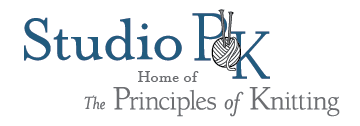Errata
Every effort was made to catch errors before POK II went to press, and I am pleased to say that so far, only a very few have come to my attention. I also want to say this is quite remarkable in a book so complex and so big — it is truly a testament to the skill and attention to detail of the copy editors.
Simon & Schuster has said they will make corrections in future printings, but only if it does not add or subtract a line and disturb the layout of a page, however, more extensive changes would have to be included in an Appendix.
Fortunately, this website not only makes it possible to provide corrections immediately to everyone who has the book, but I don’t have to worry about whether or not the change will fit on a printed page. This also means I can add comments, explanations and even new graphics, if it seems appropriate. If you find what you think is an error, or if there is an instruction you do not understand, please contact me at info@principlesofknitting.com.
In the following corrections, I have tried to make it easy to find an error in your book by providing the page number, and where necessary, the column number, and which paragraph it is in. In a quote, I have put the surrounding material in a regular font with the correction in italics. When necessary, I will provide rewritten instructions.
Chapter 1: Knitting Methods; Page 3, column 2,
Yes, that’s right, an error on the very first page!
The last sentence of the second to last paragraph should read:
“Overall the material is organized… The methods that hold the yarn on the left follows and then the one where the yarn is passed around the neck or pinned to the bodice and wrapped on the needle with the left thumb.
Location of Yarn; Page 9, column 2:
This one really upsets me because it is information for beginning knitters.
In the second column, last paragraph, and last sentence, switch “nearside” and “farside”, as follows:
“To prevent this from happening in the future, always check the position of the yarn before you begin to work; if necessary, move it between the two needle tips to the farside for Knit or nearside for Purl before making the next stitch.”
Chapter 9: Twist Stitch Foldline; Page 153,
This technique should have been called Crossed Stitch Foldline, for reasons explained in “A Change of Mind …”, page 193 (where you will also find information about Crossed Stitches), and “A Name Change …”, page 196. Fixing this also gives me the opportunity to improve the instructions for this foldline. Thank you to Dawn Laurie for bringing this to my attention.
Crossed Stitch Foldline
This produces a subtle, slightly corded edge that is quite attractive; it requires two stitches for the foldline.
Crossed Stitch Foldline at Right Edge
1. On outside, work stitches of vertical hem; on two foldline stitches, work Knit Right Crossed Stitch; continue to end of row.
2. On inside, work across row to foldline; Purl first stitch of pair, Slip second stitch of pair; strand firmly past Slip stitch to work first stitch of hem; continue to end of row.
Crossed Stitch Foldline at Left Edge
1. On outside, work across row; on two foldline stitches, work Knit Left Crossed Stitch; work stitches of vertical hem; turn.
2. On inside, work stitches of hem; at foldline, Slip first stitch of pair, strand firmly past Slip stitch and Purl second stitch; continue across row.
Twist Stitch Double Bias Foldline; Page 158,
The same error occurs here; the heading and every mention of “Twist Stitch” discussion and instructions should should be changed to “Crossed Stitch”.
Chapter 12: Trellis Insertion; Pages 248-249
In the captions for the illustrations of the Medium and Wide Trellis Insertion patterns, the names of the samples shown were switched — the ZigZag pattern is on the left and the Knotted pattern is on the right. Many thanks to Nancy Hathaway for bringing this to my attention.
Notice the decreases lean away from the Eyelets in the Knotted versions, and the border of the column is slightly ridged. The decreases lean toward the Eyelets in the ZigZag versions, the border of the column is flatter, and has a subtle zigzag appearance. When learning the pattern, pay attention to whether a decrease includes a Yarnover and a stitch, a stitch and a Yarnover, or two plain stitches; each pattern is slightly different. Stitch markers may help you keep your place.
I also thought some of you would appreciate having the instructions for working in the round:
Narrow Knotted Trellis
Row 1. Knit Left Decrease, Yarnover.
Row 2. Yarnover, Knit Right Decrease
Narrow ZigZag Trellis
Row 1. Yarnover, Knit Left Decrease.
Row 2. Knit Right Decrease, Yarnover.
Medium Knotted Trellis
Row 1: Knit 1, Yarnover, Knit Left Decrease.
Row 2: Knit Right Decrease, Yarnover, Knit 1.
Medium ZigZag Trellis
Row 1: Knit Left Decrease, Yarnover, Knit 1
Row 2: Knit 1, Yarnover, Knit Right Decrease.
Wide Knotted Trellis
Row 2. Knit 2, Yarnover, Knit Left Decrease
Row 1. Knit Right Decrease, Yarnover, Knit 1.
Wide ZigZag Trellis
Row 1. Knit Left Decrease, Yarnover, Knit 2.
Row 2. Knit 2, Yarnover, Knit Right Decrease
Chapter 21: Twined Knit; page 395
I want to thank Mr. James Small for notifying me of an error in the discussion of charting symbols used for Twined Knit.
At the end of the first paragraph, a sentence should be added:
“A series of Crook Stitches creates a pattern called Chain Path.”
At the end of the second paragraph, the last sentence is incorrect; it should read:
“The symbol on the right is the Knit version, where alternating yarns are stranded past every stitch on the outside of the fabric.”
The caption for the second set of symbols should also be corrected to read:
“Twined Knit: Left: Purl Deep Stitch; Right: Knit Deep Stitch”
